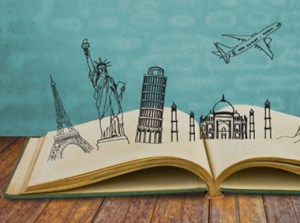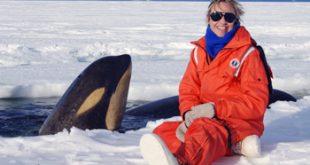Mời các bạn làm bài tập ôn luyện dạng bài Table completion trong IELTS Reading. Bài tập này giúp các bạn ôn lại kỹ năng xử lý dạng bài Table completion cũng như củng cố lượng từ vựng. Bài có tất cả 8 câu hỏi điền từ. Sau khi làm xong bài, các bạn hãy ấn submit để xem kết quả bài làm của mình và giải thích của từng câu hỏi. Bạn hãy thử làm để củng cố và nâng cao kiến thức để chuẩn bị cho bài thi IELTS Reading nhé!
Chúc bạn có thời gian hữu ích trên website!
Travel Books

There are many reasons why individuals have travelled beyond their own societies. Some travellers may have simply desired to satisfy curiosity about the larger world. Until recent times, however, travellers did start their journey for reasons other than mere curiosity. While the travellers’ accounts give much valuable information on these foreign lands and provide a window for the understanding of the local cultures and histories, they are also a mirror to the travellers themselves, for these accounts help them to have a better understanding of themselves.
Records of foreign travel appeared soon after the invention of writing, and fragmentary travel accounts appeared in both Mesopotamia and Egypt in ancient times. After the formation of large, imperial states in the classical world, travel accounts emerged as a prominent literary genre in many lands, and they held especially strong appeal for rulers desiring useful knowledge about their realms. The Greek historian Herodotus reported on his travels in Egypt and Anatolia in researching the history of the Persian wars. The Chinese envoy Zhang Qian described much of central Asia as far west as Bactria (modern- day Afghanistan) on the basis of travels undertaken in the first century BCE while searching for allies for the Han dynasty. Hellenistic and Roman geographers such as Ptolemy, Strabo, and Pliny the Elder relied on their own travels through much of the Mediterranean world as well as reports of other travellers to compile vast compendia of geographical knowledge.
During the post-classical era (about 500 to 1500 CE), trade and pilgrimage j? emerged as major incentives for travel to foreign lands. Muslim merchants sought trading opportunities throughout much of the eastern hemisphere. They described lands, peoples, and commercial products of the Indian Ocean basin from East Africa to Indonesia, and they supplied the first written accounts of societies in sub-Saharan West Africa. While merchants set out in search of trade and profit, devout Muslims travelled as pilgrims to Mecca to make their hajj and visit the holy sites of Islam. Since the prophet Muhammad’s original pilgrimage to Mecca, untold millions of Muslims have followed his example, and thousands of hajj accounts have related their experiences. East Asian travellers were not quite so prominent as Muslims during the post-classical era, but they too followed many of the highways and sea lanes of the eastern hemisphere. Chinese merchants frequently visited South-East Asia and India, occasionally venturing even to East Africa, and devout East Asian Buddhists undertook distant pilgrimages. Between the 5th and 9th centuries CE, hundreds and possibly even thousands of Chinese Buddhists travelled to India to study with Buddhist teachers, collect sacred texts, and visit holy sites. Written accounts recorded the experiences of many pilgrims, such as Faxian, Xuanzang, and Yijing. Though not so numerous as the Chinese pilgrims, Buddhists from Japan, Korea, and other lands also ventured abroad in the interests of spiritual enlightenment.
Medieval Europeans did not hit the roads in such large numbers as their Muslim and East Asian counterparts during the early part of the post-classical era, although gradually increasing crowds of Christian pilgrims flowed to Jerusalem, Rome, Santiago de Compostela (in northern Spain), and other sites. After the 12th century, however, merchants, pilgrims, and missionaries from medieval Europe travelled widely and left numerous travel accounts, of which Marco Polo’s description of his travels and sojourn in China is the best known. As they became familiar with the larger world of the eastern hemisphere – and the profitable commercial opportunities that it offered – European peoples worked to find new and more direct routes to Asian and African markets. Their efforts took them not only to all parts of the eastern hemisphere, but eventually to the Americas and Oceania as well.
If Muslim and Chinese peoples dominated travel and travel writing in post- classical times, European explorers, conquerors, merchants, and missionaries took centre stage during the early modern era (about 1500 to 1800 CE). By no means did Muslim and Chinese travel come to a halt in early modern times. But European peoples ventured to the distant corners of the globe, and European printing presses churned out thousands of travel accounts that described foreign lands and peoples for a reading public with an apparently insatiable appetite for news about the larger world. The volume of travel literature was so great that several editors, including Giambattista Ramusio, Richard Hakluyt, Theodore de Biy, and Samuel Purchas, assembled numerous travel accounts and made them available in enormous published collections.
During the 19th century, European travellers made their way to the interior regions of Africa and the Americas, generating a fresh round of travel writing as they did so. Meanwhile, European colonial administrators devoted numerous writings to the societies of their colonial subjects, particularly in Asian and African colonies they established. By mid-century, attention was flowing also in the other direction. Painfully aware of the military and technological prowess of European and Euro-American societies, Asian travellers in particular visited Europe and the United States in hopes of discovering principles useful for the organisation of their own societies. Among the most prominent of these travellers who made extensive use of their overseas observations and experiences in their own writings were the Japanese reformer Fukuzawa Yu- kichi and the Chinese revolutionary Sun Yat-sen.
With the development of inexpensive and reliable means of mass transport, the 20th century witnessed explosions both in the frequency of long-distance travel and in the volume of travel writing. While a great deal of travel took place for reasons of business, administration, diplomacy, pilgrimage, and missionary work, as in ages past, increasingly effective modes of mass transport made it possible for new kinds of travel to flourish. The most distinctive of them was mass tourism, which emerged as a major form of consumption .for individuals living in the world’s wealthy societies. Tourism enabled consumers to get away from home to see the sights in Rome, take a cruise through the Caribbean, walk the Great Wall of China, visit some wineries in Bordeaux, or go on safari in Kenya. A peculiar variant of the travel account arose to meet the needs of these tourists: the guidebook, which offered advice on food, lodging, shopping, local customs, and all the sights that visitors should not miss seeing. Tourism has had a massive economic impact throughout the world, but other new forms of travel have also had considerable influence in contemporary times.
Questions 1-8
Complete the table on the next page.
Choose NO MORE THAN TWO WORDS from Reading Passage 3 for each answer.
|
TIME |
TRAVELLER |
DESTINATION |
PURPOSE OF TRAVEL |
|
Classical Greece |
Herodotus |
Egypt and Anatolia |
To gather information for the study of 1__________ |
|
Han Dynasty |
Zhang Qian |
Central Asia |
To seek 2_____________ |
|
Roman Empire |
Ptolemy, Strabo, Pliny the Elder |
The Mediterranean |
To acquire 3_______________ |
|
Post-classical era (about 500 to 1500 CE) |
Muslims |
From East Africa to Indonesia, Mecca |
For trading and 4___________ |
|
5th – 9thCenturies CE |
Chinese Buddhists |
5_____________ |
To collect Buddhist texts and for spiritual enlightenment |
|
Early modern era (about 1500 to 1800 CE) |
European explorers |
The New World |
To satisfy public curiosity for the New World |
|
During 19th century |
Colonial administrators | Asia, Africa | To provide information for the 6____________they set up |
|
By mid-century of the 1800s |
Sun Yat-sen, Fukuzawa Yukichi |
Europe and the United States | To study the 7__________of their societies |
| 20th century | People from
8_________countries
|
Mass tourism | For entertainment and pleasure |
 IELTS Max Luyện thi IELTS cam kết đầu ra
IELTS Max Luyện thi IELTS cam kết đầu ra




